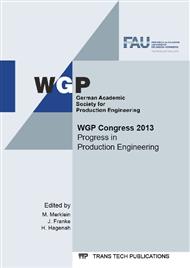[1]
Y. Qin, A. Brocket, Y. Ma, A. Razali, J. Zhao, C. Harrison, W. Pan, X. Dai, D. Loziak, Micro-manufacturing: research, technology outcomes and development issues, Int. J. Adv. Manuf. Technol. 47 (2010) 821–837.
DOI: 10.1007/s00170-009-2411-2
Google Scholar
[2]
J.P. Wulfsberg, T. Redlich, P. Kohrs, Square foot manufacturing: a new production concept for micro manufacturing, Prod. Eng. 4(1) (2010) 75–83.
DOI: 10.1007/s11740-009-0193-x
Google Scholar
[3]
Y. Okazaki, N. Mishima, K. Ashida, Microfactory–concept, history, and developments, J. Manuf. Sci. Eng. 126(4) (2004) 837–844.
DOI: 10.1115/1.1823491
Google Scholar
[4]
Information on: http://www.wtec.org/micromfg/report/Micro-report.pdf
Google Scholar
[5]
R. E. DeVor, S. G. Kapoor, J. Cao, K. F. Ehmann, Transforming the landscape of manufacturing: distributed manufacturing based on desktop manufacturing (DM)2, J. Manuf. Sci. Eng. 134(4) (2012) 041004.1-041004.11.
DOI: 10.1115/1.4006095
Google Scholar
[6]
A. Hofmann, G. Bretthauer, N. Siltala, R. Tuokko, Evolvable micro production systems: specific needs and differences to macro, ISAM (2011).
DOI: 10.1109/isam.2011.5942361
Google Scholar
[7]
J. P. Wulfsberg, B. Röhlig, Paradigm change: small machine tools for small workpieces, Prod. Eng. (2013) currently being published.
DOI: 10.1007/s11740-013-0457-3
Google Scholar
[8]
P. Nyhuis, T. Heinen, G. Reinhart, C. Rimpau, E. Abele, Transformable production systems: theoretical background to the transformability of production systems, wt Werkstattstechnik online 1(2) (2008) 85–91.
DOI: 10.37544/1436-4980-2008-1-2-85
Google Scholar
[9]
J. Lehmann, Kombinierte multifunktionale Arbeitsräume zur Restrukturierung der Mikroproduktion, Dissertation, Helmut Schmidt University, University of the Federal Armed Forces Hamburg (2007).
Google Scholar
[10]
J. P. Wulfsberg, S. Grimske, P. Kohrs, N. Kong, Small machine tools for small work pieces: objectives and scientific approach of the DFG program 1476, wt Werkstattstechnik online 11(12) (2010) 886–891.
DOI: 10.37544/1436-4980-2010-11-12-886
Google Scholar
[11]
D. Derfling, Einsatz von Industrierobotern als Koordinatenmessgeräte, Dissertation, Helmut Schmidt University, University of the Federal Armed Forces Hamburg (2013) submitted.
Google Scholar
[12]
F. Vollertsen, D. Biermann, H. N. Hansen, I. S. Jawahir, K. Kuzman, Size effects in manufacturing of metallic components, CIRP Annals Manuf. Technol., 58(2) (2009) 566-587.
DOI: 10.1016/j.cirp.2009.09.002
Google Scholar
[13]
F. Vollertsen, Prozessskalierung, Tagungsband des 2. Kolloquiums Prozessskalierung im Rahmen des DFG Schwerpunktprogramms Prozessskalierung, Strahltechnik, Band 27, BIAS Verlag, Bremen, 2005.
Google Scholar
[14]
G. Simons, C. Weippert, J. Dual, J. Villain, Size effects in tensile testing of thin cold rolled and annealed Cu foils, Material Sience and Engineering, A 416 (2006) 290-299.
DOI: 10.1016/j.msea.2005.10.060
Google Scholar
[15]
A. Albers, P. Börsting, S. Matthiesen, Obstacles for cognitive analogy in analyses and synthesis in microsystem development, Microsys. Technol. 19 (2012) 371-378.
DOI: 10.1007/s00542-012-1627-5
Google Scholar
[16]
P. Kohrs, Development and verification of a new feed unit for small machine tools, Dissertation, Helmut Schmidt University, University of the Federal Armed Forces Hamburg (2011).
Google Scholar
[17]
The Association of German Engineers (VDI), VDI 2221, Systematic approach to the development and design of technical systems and products, 1993.
Google Scholar
[18]
The Association of German Engineers (VDI), VDI 2206, Design methodology for mechatronic systems, 2004.
Google Scholar
[19]
K. Ehrlenspiel, Integrierte Produktentwicklung, Hanser, Munich, 2009.
Google Scholar
[20]
M. Meboldt, Mental and formal modelling, a contribution to the integrated product development model (iPeM), Dissertation, University of Karlsruhe(TH) (2008).
Google Scholar
[21]
U. Lindemann, Methodische Entwicklung technischer Produkte, Springer, Berlin, 2005.
Google Scholar
[22]
M. A. Orloff, Grundlagen der klassischen TRIZ, Springer, Berlin 2002.
Google Scholar
[23]
A. Albers, J. Marz, N. Burkardt, Design Methodology in Micro Technology, 14th Int. Conf. on Eng. Design (2003).
Google Scholar
[24]
L. Alting, F. Kimura, H. N. Hansen, G. Bissacco, Micro Engineering, CIRP Annals Manuf. Technol., 52(2) (2003) 635-657.
DOI: 10.1016/s0007-8506(07)60208-x
Google Scholar


